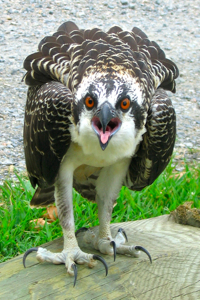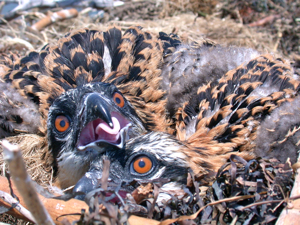Breeding Habits

The following material is adapted with permission from a fact sheet produced by the Hawk Mountain Sanctuary in eastern Pennsylvania.
Historically, Chesapeake Bay has supported the largest concentration of breeding ospreys in the world.
Ospreys are usually monogamous. Pairs repeatedly return to the same nest site, and often remain together for many years, sometimes for life. Older individuals, and in particular pairs that have bred together previously, tend to be more successful than newly formed pairs. Ospreys typically breed for the first time when they are 3 or 4 years old.
Males return to the breeding grounds before females and select the nest site. Some males perform aerial displays even before females arrive. The displays, which peak after the female arrives, allow the male to mark his territory and to solicit the attention of a female. So called sky dances usually begin and end at the nest site, and while performing the display, males usually carry a fish or nesting material and call repeatedly. Sky dances incorporate undulating flights, which sometimes reach heights of 300 feet or more. At the top of each undulation, males typically hover briefly with their legs dangling and their tails fanned, and then dive downward with their wings drawn in. They may repeat this sequence several times. During courtship, males also provide food for their mates, follow them closely, and chase away other males.
Nesting
Ospreys prefer to build their large stick nests near water at sites with good visibility and limited access for predators. Typical nest sites include dead or relatively open live trees in or within a few kilometers of open water. Cliffs, rocky outcrops, and even cacti are sometimes used. On rare occasions, ospreys nest on the ground. They also nest on utility poles, duck blinds, channel markers, and nesting platforms erected specifically for them. Nests usually are renovated and reused annually either until the base collapses or until the nest is damaged in a storm.
Nests often are 5 feet across and 2-3 feet deep when they are first built and increase in size each year thereafter. Smaller birds, including House Sparrows and Monk Parakeets, sometimes nest within an osprey’s nest. Osprey pairs can construct their nests in as few as 7 to 10 days. Males gather most of the material for the main structure and females collect most of the material for the nest lining. Although pairs defend the immediate area around the nest, ospreys sometimes nest in loose colonies in areas where prey is abundant.
A 2004 study by researchers with W&M's Center for Conservation Biology (CCB) studied nesting patterns among Chesapeake Bay ospreys and compared their finding with a nesting study done in 1973. They found that use of trees for nesting had declined from 31.7% to 7.2% during that 23-year period. Channel markers accounted for 53.5% of all nest structures in the 2004 study, whereas platforms established specifically for ospreys supported 12.1% of pairs. The authors conclude that the proliferation and diversification of man-made nest sites throughout Chesapeake Bay has been one of the most important factors contributing to recent expansion of the Bay's osprey population.
 The Clutch
The Clutch
Ospreys typically lay 2- or 3- egg clutches. Incubation begins when the first egg is laid and clutches hatch asynchronously. When food is limiting, younger chicks that are unable to compete with their larger, older siblings often starve. Females do most of the incubating during the 34 to 40 day incubation period. After the eggs hatch, the female broods the nestlings continually for 10 days. Throughout this period, the male provides food for the female.
Nestlings are able to feed themselves when they are about six weeks old, at which time females begin to hunt for themselves and their young. The young leave the nest when they are 7 to 8 weeks old, and will continue to roost at and around the nest for another month. During the day, fledglings perch near the nest and will sometimes fly after the male begging for food while he hunts. Young usually catch their first fish 2 to 8 weeks after fledging.

